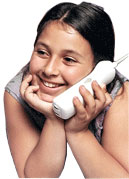
Lifeline

Lifeline is a Federal assistance program which provides a financial subsidy in order to
make it more affordable for low-income families and households to maintain basic telephone service.
If you believe that you may qualify for this service, you should contact your current home phone or cell
phone service supplier. If your current providers don't offer Lifeline discounts, you can easily find
on that will by searching the internet. The USAC administers the fund that gives the subsidy to your
provider who in turn passes that along to you in the form of a discount off of your bill or possibly free
wireless minutes which could result in a no-cost-to-you plan
According to the rules set by the Federal government, a household is allowed to receive just one
Lifeline subsidy. This subsidy can be on either home landline phone service or one cellular phone.
Two people from the same household cannot each have a Lifeline supported phone.
Qualification Guide for Lifeline
To be qualified to receive Lifeline, as of 6/1/2012:
- No members of your household can already be receiving Lifeline benefits.
- Someone in the household must be enrolled in a qualifying Government assistance program or, the entire houseehold income must not be in excess of 135% of the poverty level as put forth by the Federal government.
- You, as the applicant, must read, fill out and sign a Lifeline certification of eligility. This document is supplied by your provider.
- You must provide proof of Lifeline eligibility (This means that you will need to prove that you are enrolled in one of the qualifying government programs by submitting documentation showing your participation. This can be a picture of your program card, copy of your award letter, statement of benefits, letter of participation, or some other type of official document. If you qualify based on your income, you will need to provide proof of income.)
For more information and details regarding the Lifeline program go to the USAC website.
What You Should Know
- Lifeline is a federal benefit and willfully making false statements to obtain the benefit can result in fines, imprisonment, de-enrollment or being barred from the program.
- A household is allowed only one Lifeline service (wire line or wireless).
- A "household" is defined as an individual or group of individuals who live together at the same address and share income and expenses.
- A household is NOT allowed to receive Lifeline benefits from multiple providers.
- Exceeding the one-per-household limitation constitutes a violation of the Commission's rules and will result in the subscriber's de-enrollment from the program; and potentially prosecution by the U.S. Government.
- Lifeline is a non-transferable benefit. The subscriber may not transfer his or her benefit to any other person.